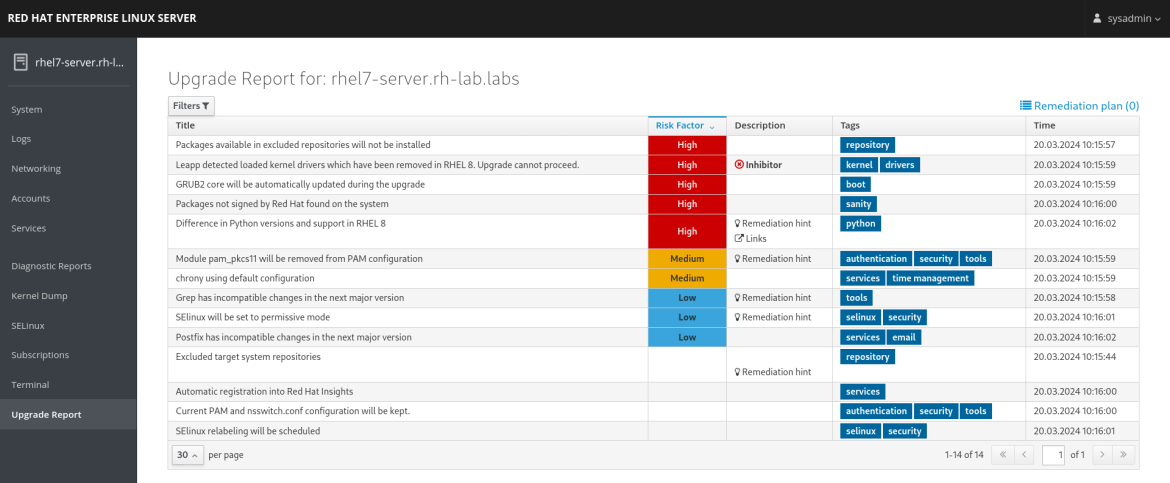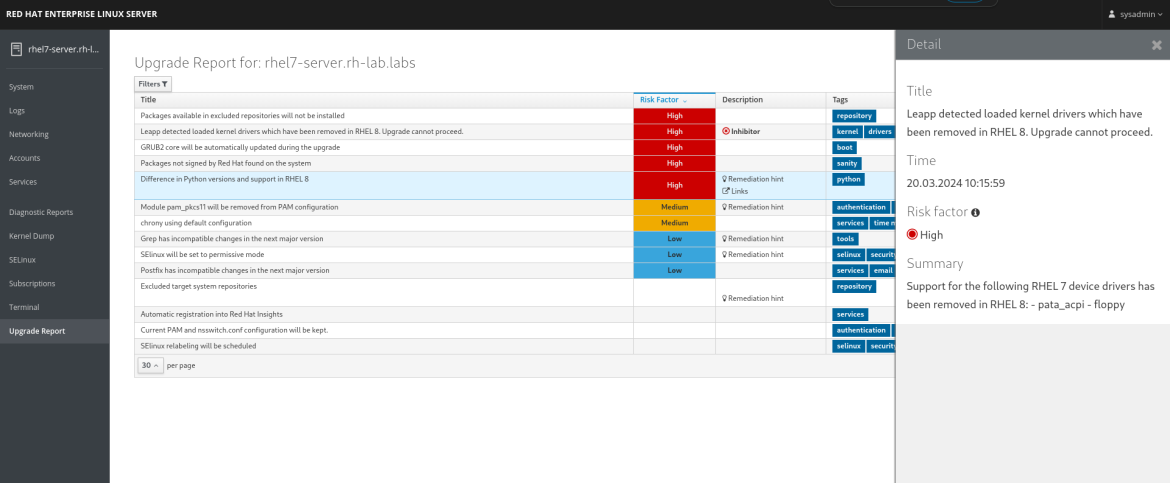Seamlessly upgrading an operating system in-place can be one of the biggest challenges due to potential package incompatibility, kernel customizations, or outdated and unsupported modules. This is where a structured tool can make all the difference, guiding the user through the process, from pre-requisite checks to the actual upgrade, along with helpful suggestions and insightful analysis.
An overview of the Leapp tool
Leapp is the tool offered in Red Hat Enterprise Linux (RHEL) to support you through an in-place upgrade of a system from supported versions of RHEL:
- RHEL 7.9 to RHEL 8.6/8.8/8.9
- RHEL 8.6 to RHEL 9.0
- RHEL 8.7 to RHEL 9.2
- RHEL 8.8 to RHEL 9.3
What makes Leapp unique is the ability to provide the user with pre-upgrade analysis capabilities that can run on your servers before the upgrade. This test can reveal inconsistencies that could cause issues or prevent an upgrade. During the pre-upgrade analysis, many checks are performed:
- Package compatibility
- Repositories support across versions
- Configuration conflicts for base packages and services
- Incompatible and unsupported kernel modules
- Bootloader inconsistencies
The Leapp tool is also available for at-scale pre-upgrade and upgrade tasks in Red Hat Satellite. A specific application to view and manage pre-upgrade reports is available in the RHEL web console.
Performing a pre-analysis with Leapp
Assume you've just migrated from CentOS Linux 7 to RHEL 7.9, and you now want to upgrade your system to RHEL 8.9.
As I mentioned above, Leapp is included in the base repositories for RHEL as a package. Install it and its dependencies:
$ sudo yum install leapp
To view and interact with the report, you must also install and enable the RHEL web console and the extension for Leapp:
$ sudo yum install cockpit cockpit-leapp
Next, enable the web console so that it can be accessed on port 9090 (adjust your firewall settings as necessary):
$ sudo systemctl enable cockpit.socket cockpit
Then reboot your system:
$ sudo reboot
Once all the packages are in place, you're ready to run the report:
$ sudo leapp preupgrade --target 8.9
After a couple of minutes, a summary is displayed:
=============== REPORT OVERVIEW =============== Upgrade has been inhibited due to the following problems: 1. Leapp detected loaded kernel drivers which have been removed in RHEL 8. Upgrade cannot proceed. HIGH and MEDIUM severity reports: 1. Packages available in excluded repositories will not be installed 2. GRUB2 core will be automatically updated during the upgrade 3. Packages not signed by Red Hat found on the system 4. Difference in Python versions and support in RHEL 8 5. Module pam_pkcs11 will be removed from PAM configuration 6. chrony using default configuration Reports summary: Errors: 0 Inhibitors: 1 HIGH severity reports: 4 MEDIUM severity reports: 2 LOW severity reports: 3 INFO severity reports: 4 Before continuing consult the full report: A report has been generated at /var/log/leapp/leapp-report.json A report has been generated at /var/log/leapp/leapp-report.txt ====================== END OF REPORT OVERVIEW ======================
Dedicated report files are generated in the /var/log/leapp directory to review, but you've installed and enabled the RHEL web console so you can view them rendered.
Reading the pre-upgrade analysis report
In a web browser, navigate to https://yourserverhost:9090 and log in. The latest pre-upgrade report is filed under the Upgrade Report section of the UI.

Based on your actual system configuration, your results may be different, but in general, this is a good example of a detailed report. It includes:
- The type of check performed, and any problems detected
- A risk factor associated with the entry (for example, incompatible packages, version drifts, unsupported or removed features, configurations, and modules)
- A description of the issue, how to resolve it, and whether it is a blocker to the upgrade
Take a look at what the report suggests for the Inhibitor issue that was detected. Click on the entry to open a window with a description and impacted entries:

In this example, specific device drivers that are not present in RHEL8 are detected. In this case, you could proceed with applying the fix. In other cases, where a resolution is not present, or the reported information is not impacting your workloads and system, it could be enough to acknowledge them.
Once everything is taken care of, you're able to run the upgrade.
Conclusion
Leveraging the Leapp pre-upgrade analysis tool can streamline and mitigate risk during your RHEL upgrade process. By providing comprehensive checks and actionable insights, it empowers users to address potential issues proactively, providing a smoother transition to new RHEL versions. Let Leapp navigate you through uncertainties and optimize your system upgrades!
About the author
Alessandro Rossi is an EMEA Senior Specialist Solution Architect for Red Hat Enterprise Linux with a passion for cloud platforms and automation.
Alessandro joined Red Hat in 2021, but he's been working in the Linux and open source ecosystem since 2012. He's done instructing and consulting for Red Hat and delivered training on Red Hat Enterprise Linux, Red Hat Ansible Automation Platform and Red Hat OpenShift, and has supported companies during solutions implementation.
More like this
Browse by channel
Automation
The latest on IT automation for tech, teams, and environments
Artificial intelligence
Updates on the platforms that free customers to run AI workloads anywhere
Open hybrid cloud
Explore how we build a more flexible future with hybrid cloud
Security
The latest on how we reduce risks across environments and technologies
Edge computing
Updates on the platforms that simplify operations at the edge
Infrastructure
The latest on the world’s leading enterprise Linux platform
Applications
Inside our solutions to the toughest application challenges
Original shows
Entertaining stories from the makers and leaders in enterprise tech
Products
- Red Hat Enterprise Linux
- Red Hat OpenShift
- Red Hat Ansible Automation Platform
- Cloud services
- See all products
Tools
- Training and certification
- My account
- Customer support
- Developer resources
- Find a partner
- Red Hat Ecosystem Catalog
- Red Hat value calculator
- Documentation
Try, buy, & sell
Communicate
About Red Hat
We’re the world’s leading provider of enterprise open source solutions—including Linux, cloud, container, and Kubernetes. We deliver hardened solutions that make it easier for enterprises to work across platforms and environments, from the core datacenter to the network edge.
Select a language
Red Hat legal and privacy links
- About Red Hat
- Jobs
- Events
- Locations
- Contact Red Hat
- Red Hat Blog
- Diversity, equity, and inclusion
- Cool Stuff Store
- Red Hat Summit

